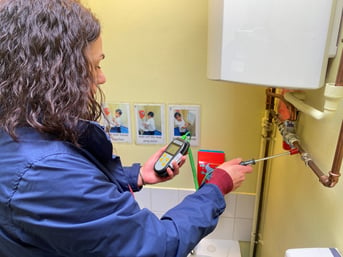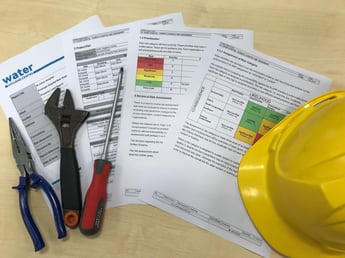
In Part 1, we covered some common problems you may face when commissioning Legionella risk assessments. We now take a look at what your risk assessment should include to comply with current guidance and regulations.
Identification, assessment and review of risks
The HSE reissued ACoP L8 in 2013 followed by the supporting technical guidance known as HSG274, which comes in three parts:
- Part 1 – The control of legionella bacteria in evaporative cooling systems;
- Part 2 – The control of legionella bacteria in hot and cold water systems;
- Part 3 – The control of legionella bacteria in other risk systems.
The ACOP L8 and HSG274 suite of documents, offers advice on managing water systems. Including the need to carry out a Legionella risk assessment to identify the risks and the means to control them. The HSE have detailed a checklist in each of the HSG274 documents outlining the most common requirements when assessing risk, some of the more interesting requirements include:
- Details of management processes;
- Assessment of the Legionella training and competence of those associated with risk management and those involved in control and monitoring activities;
- Identification of roles and responsibilities;
- Evidence of proactive management and follow up to the previous risk assessment;
- An assessment on the validity of the schematic diagram.
Plainly, risk assessments are not just looking at water systems! Service providers must ensure that the requirements detailed in the HSG274 checklists are included in their risk assessment methodology.
 To further compliment the guidance, the HSE refers to the British Standard Institution’s BS 8580 ‘Water quality. Risk assessments for Legionella control. Code of Practice’. This standard is applicable to any premises or work activity where water is used or stored that could cause a reasonably foreseeable risk of exposure to Legionella bacteria. The methodology of the standard covers risk assessments completed for the first time, review and auditing of control measures.
To further compliment the guidance, the HSE refers to the British Standard Institution’s BS 8580 ‘Water quality. Risk assessments for Legionella control. Code of Practice’. This standard is applicable to any premises or work activity where water is used or stored that could cause a reasonably foreseeable risk of exposure to Legionella bacteria. The methodology of the standard covers risk assessments completed for the first time, review and auditing of control measures.
Risk assessments completed to BS8580 methodology should include the following:
- An assessment of:
- occupant susceptibility;
- management processes;
- processes for monitoring data;
- record keeping;
- inherent risk and actual risk.
- A repeatable means of assessing the level of risk, such as a scoring system or matrix [although one is not defined in BS8580];
- A comparison of the assessed risk to the acceptable level of risk [this acceptable level of risk is referred to as ALARP, which stands for ‘as low as reasonably practicable’];
- Recommendations designed to reduce the risk to the ALARP level, as required.
Again, this is not an exhaustive list, but here we’ve highlighted the need to consider the level of acceptable risk. ALARP should be considered for each water system as it may vary. This encourages a more pragmatic approach to managing Legionella risk, helping to ensure that resources are neither wasted nor under-deployed.
Legionella risk assessment reporting
 To complete the process the assessor will prepare a formal risk assessment report. BS 8580 indicates that reporting should involve the following:
To complete the process the assessor will prepare a formal risk assessment report. BS 8580 indicates that reporting should involve the following:
- Firstly, if the assessor identifies any imminent dangers these should be communicated urgently to the responsible person without waiting for the written report.
- The written report be clear and unambiguous in its findings and should detail:
- The results of the risk assessment including tests, measurements, checks and recommended remedial works;
- An explanation of the scope of the assessment;
- Identify the key people including duty holder and the responsible person;
- Be sufficiently detailed to allow an understanding of the key issues and actions required to control the risk;
- The report should be written in such a way as to be readily understood by the intended recipients.
Managers will primarily be interested in what they need to do following the risk assessment. For this reason, the report should contain detailed recommendations, listed in order of priority with a suggestion of the reasonable timescale for completion. Using this information, a plan can be developed for implementation taking account of the available resources and the requirements of the risk assessment.
Summary
In this blog we’ve highlighted some common issues with Legionella risk assessments. When it comes to these assessments and what they should include, there is clear guidance from both the HSE and BSi that is applicable to all Legionella risk assessments wherever they are carried out.
Hospitality & leisure premises are no different in this respect. The manager responsible is required to check the competency of risk assessors, including external service providers. BS 8580 states that the assessor should have “specialist knowledge of Legionella bacteria, relevant water treatment and the water systems to be assessed” and that they “should be able to demonstrate impartiality and integrity”.
Feel free to reach out if you have any questions about this blog or if you would like to consult with one of our experts for further advice on water hygiene.
Editors Note: The information provided in this blog is correct at date of original publication - December 2018.
© Water Hygiene Centre 2018
Image by Nenad Maric from Pixabay








